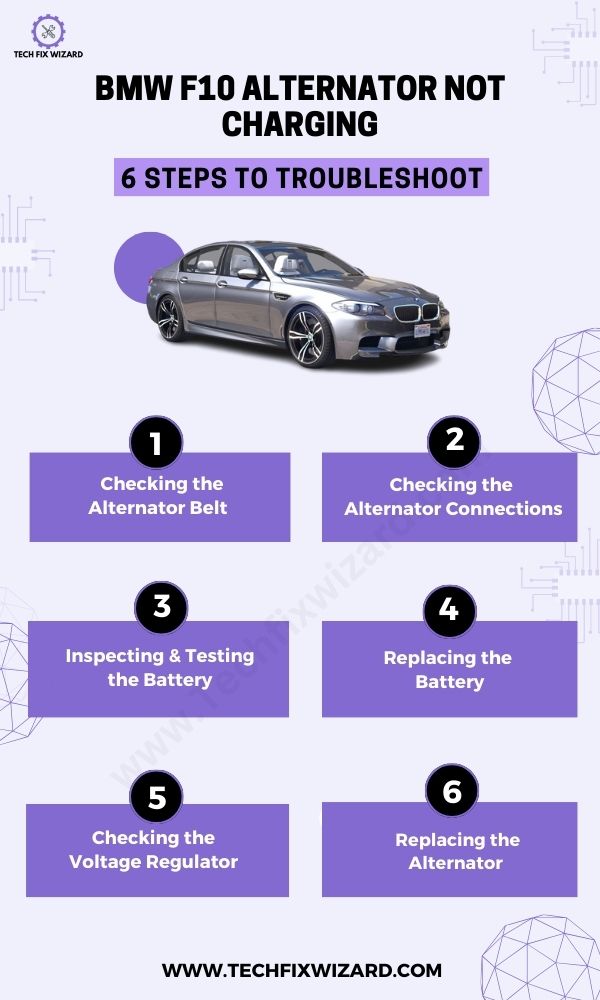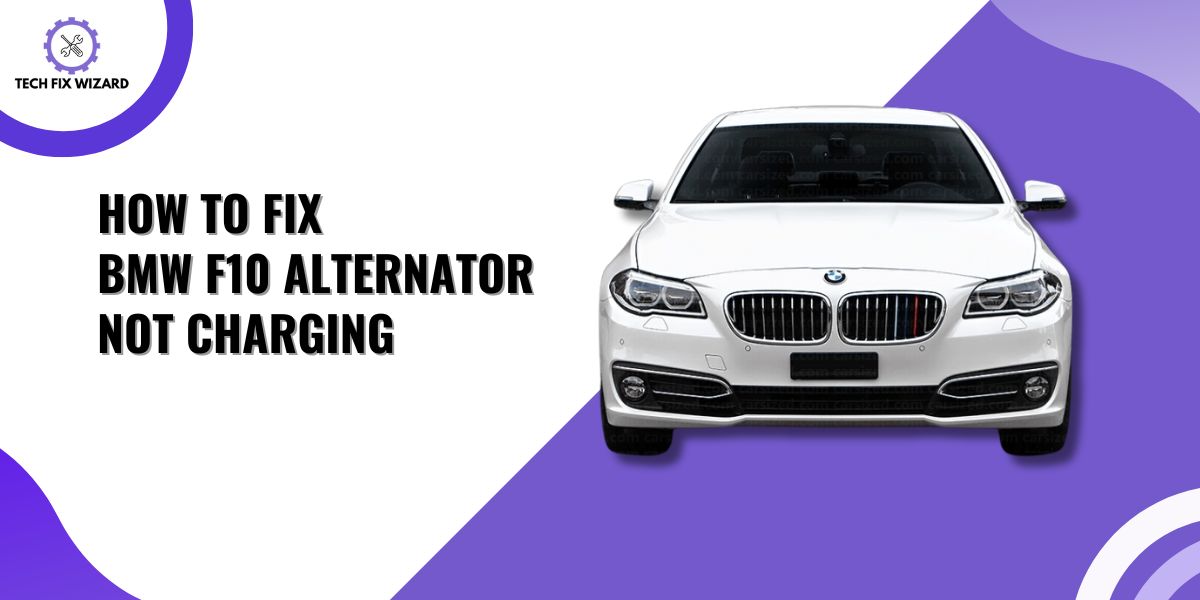If you own a BMW F10, you know that it’s a sleek and powerful vehicle. However, even the most well-maintained cars can develop issues over time.
One common problem that many BMW F10 owners face is when their alternator stops charging properly.
When this happens, your battery won’t be able to maintain its charge and your car won’t start.
Don’t worry though, because in this article we’ll show you how to fix your BMW F10 alternator not charging so you can get back on the road.
Contents
- 1 BMW F10 Alternator Not Charging – Symptoms of a Faulty Alternator
- 2 BMW F10 Alternator Not Charging Solved in 6 Troubleshooting Steps
- 3 1. Checking the Alternator Belt
- 4 2. Checking the Alternator Connections
- 5 3. Inspecting & Testing the Battery
- 6
- 7 4. Replacing the Battery in a BMW F10
- 8 5. Checking the Voltage Regulator
- 9 6. Replacing the Alternator in Your BMW F10
- 10 Maintenance Tips to Prevent Alternator Issues in the Future
- 11 FAQs
- 12 What are the signs of a BMW F10 alternator not charging?
- 13 What could be the possible reasons for the BMW F10 alternator not charging?
- 14 How can I check if the alternator is the problem?
- 15 Can I continue driving my BMW F10 if the alternator is not charging?
- 16 Can a bad battery cause the alternator not to charge?
- 17 How often should I replace the alternator in my BMW F10?
- 18 Can I replace the alternator in my BMW F10 myself?
- 19 How much does it cost to replace the alternator in a BMW F10?
- 20 Is it necessary to use an OEM alternator for my BMW F10?
- 21 Official References & Resources
BMW F10 Alternator Not Charging – Symptoms of a Faulty Alternator
A faulty alternator in a BMW F10 shows various symptoms. BMW F10 owners must be vigilant and address these symptoms promptly.
The following table will provide you with some of the common symptoms of a faulty alternator in your BMW F10.
| No. | Symptom | Possible Cause |
|---|---|---|
| 1 | Dimming headlights or a dead battery | Faulty alternator resulting in inadequate charging |
| 2 | The dashboard warning light stays on after starting | Alternator failure leading to insufficient battery charging |
| 3 | Difficulty in starting the vehicle | Insufficient power from the alternator to charge the battery |
| 4 | Clicking noise during ignition | Inadequate power supply to start the car |
| 5 | Strange noises from under the hood | Failing alternator pulley bearing or belt tensioner, causing a squealing sound during operation |
BMW F10 Alternator Not Charging Solved in 6 Troubleshooting Steps
After learning about the possible symptoms of the BMW F10 alternator not charging issue, let’s begin our systematic approach to identifying and resolving this issue.

Read More: BMW F10 Battery Not Charging – 5 Practical Solutions
1. Checking the Alternator Belt
First things first, start your troubleshooting by taking a quick look at the belt and connections of your BMW to make sure everything is working properly.
The alternator belt is responsible for driving the alternator rotor, which in turn charges the battery. A loose or damaged belt can cause the alternator to stop charging or not charge properly.

To check the condition of the belt:
- Open the hood.
- Do a visual inspection of the alternator belt:
- Check for cracks on the belt surface.
- Look for fraying or worn edges.
- Identify any signs of excessive wear or damage.
- If you notice anything unusual during the inspection, replace the belt immediately to avoid further issues.
2. Checking the Alternator Connections
The next step in our troubleshooting process is to check all connections related to the alternator system.
Make sure that all terminals are tightly connected and free from corrosion. Corrosion can hinder electrical conductivity and prevent proper charging. Take a close look at each connection point for signs of damage or looseness.
3. Inspecting & Testing the Battery
Once you’ve checked the alternator belt and connections, you should check and test your battery to ensure it’s holding a proper voltage and charge.
A faulty battery can affect the overall charging system, and if the battery is unable to hold a proper voltage and charge, it can put additional strain on the alternator.
Here are some simple steps for checking and testing the battery:
Inspecting the Battery
For battery inspection follow the steps below:
| Step | Action | Description |
|---|---|---|
| 1. | Locate the car battery | Find the car battery in the engine compartment or trunk.
Check for any visible signs of damage or corrosion, such as cracks or bulges. |
| 2. | Inspect the battery for damage | Carefully examine the battery for any visible damage or signs of wear.
Look for cracks, bulges, or corrosive buildup around the terminals. If you notice any issues, such as cracks or bulges, consider replacing the battery immediately. |
Testing the Battery
You can follow 5 simple steps below to test the voltage of your battery using a multimeter:
| Step | Action | Description |
|---|---|---|
| 1. | Turn off the car engine | Ensure the car engine is off to get an accurate reading of the battery voltage. |
| 2. | Attach the multimeter to the battery terminals | Using a multimeter, connect the positive (red) lead to the positive terminal of the battery and the negative (black) lead to the negative terminal. |
| 3. | Check the voltage of the battery | With the multimeter properly connected, read the voltage. A fully charged battery should read around 12.6 volts or higher.
If the reading is below 12 volts, the battery may be discharged and needs to be recharged before retesting. |
| 4. | Recharge the battery (if necessary) | If the battery voltage is low, recharge it using a suitable battery charger before retesting. |
| 5. | Interpret the results | Based on the voltage reading, assess the health of the battery.
A low voltage reading could indicate a weak or failing battery that may need replacement. |
You May Also Like: Bmw F20 Battery Not Charging – 8 Solutions To Try
4. Replacing the Battery in a BMW F10
After conducting the necessary testing, if you determine that your BMW F10 requires a battery replacement, you can follow the steps below:
- Turn off the engine and engage the parking brake.
- Remove the trunk floor cover to access the battery compartment.
- Refer to the vehicle’s manual or online resources to locate the battery.
- Disconnect the negative terminal (-) using a wrench or socket.
- Disconnect the positive terminal (+) using a wrench or socket.
- Remove any retaining brackets or straps securing the battery.
- Lift the old battery out of the compartment, being careful not to tip or spill.
- Position the new battery in the compartment and secure it with brackets or straps.
- Connect the positive terminal (+) and tighten the terminal nut securely.
- Connect the negative terminal (-) and tighten the terminal nut securely.
- Test the new battery by starting the engine and checking for any issues.
5. Checking the Voltage Regulator
The next step is to check the voltage regulator, which is responsible for regulating the amount of voltage that enters the battery from the alternator.
If your BMW has a faulty voltage regulator, the alternator may not charge properly.
- Start the car and let it run for a few minutes.
- Turn on your headlights.
- Measure the voltage at the battery terminals using a multimeter.
- The reading should be between 13.5 and 14.5 volts DC.
- If the voltage is lower than this range or fluctuates rapidly, it may indicate a faulty voltage regulator.

Inspect Wiring Harness and Connections:
Now, for the inspection of the wiring harness and the connections you can follow the following steps:
- Check the wiring harness and connections of the voltage regulator.
- Look for signs of damage or corrosion.
- Damaged or corroded connections can lead to poor electrical conductivity.
- Improper charging of the vehicle’s battery may result from faulty connections.
- If any issues are found, consider replacing the components promptly to avoid further damage to the charging system and battery life.
Also Read: BMW F30 Battery Not Charging – 7 Solutions To Try
6. Replacing the Alternator in Your BMW F10
As a last resort in the troubleshooting process, if all other potential issues have been ruled out, and your BMW F10 alternator is still experiencing charging problems, it may be time to consider replacing the alternator.
Replacing the Alternator of the BMW F10:
Follow the steps below to replace the alternator to resolve the charging issue:
- Ensure the engine is off and engage the parking brake.
- Open the hood and locate the alternator at the front of the engine.
- Disconnect the negative battery cable using a wrench or socket.
- Disconnect the wiring harness from the alternator.
- Loosen the bolts or adjust the bracket securing the alternator.
- Remove the old alternator from its mounting position.
- Position the new alternator in the mounting location.
- Secure the new alternator with bolts or adjusting brackets.
- Reconnect the wiring harness and electrical connectors.
- Reconnect the negative battery cable and tighten the terminal nut.
- Close the hood and start the engine to test the new alternator.
Maintenance Tips to Prevent Alternator Issues in the Future
By regularly maintaining your vehicle, you can ensure it runs smoothly and avoid costly breakdowns down the road.
Follow are the 5 simple maintenance tips that you can use to prevent alternator issues from occurring in your BMW F10 and keep it running smoothly for years to come.
- Keep the battery terminals and connections clean and free of corrosion.
- Regularly check the condition and tension of the alternator belt.
- Replace any worn or damaged belts promptly to avoid strain on the alternator.
- Overheating can damage the alternator, so ensure proper coolant levels and a well-functioning cooling system.
- It’s important to have your BMW F10 serviced by a qualified mechanic at regular intervals.
Our Popular Posts:
- BMW Wireless Not Charging – 9 Causes And Easy Fixes
- BMW Wallbox Not Charging – 6 Effective Solutions To Try
- BMW Not Charging iPhone – 7 Quick & Easy Solutions
FAQs
What are the signs of a BMW F10 alternator not charging?
Some common signs of a faulty alternator in the BMW F10 include dimming headlights, a battery warning light on the dashboard, slow cranking or difficulty starting the engine, and a discharged or dead battery.
What could be the possible reasons for the BMW F10 alternator not charging?
Several reasons can lead to an alternator not charging properly. The most common ones are a faulty alternator, a broken serpentine belt, a damaged voltage regulator, or corroded/bad electrical connections.
How can I check if the alternator is the problem?
You can perform a simple test with a voltmeter. Start the engine and measure the voltage across the battery terminals.
The voltage should read around 13.5 to 14.5 volts. If it’s significantly lower or not increasing with engine RPM, the alternator might not be charging.
Can I continue driving my BMW F10 if the alternator is not charging?
It is not advisable to drive with a non-charging alternator for an extended period. As the battery depletes, critical systems may fail, leading to a breakdown.
It’s best to address the issue promptly to avoid further complications.
Can a bad battery cause the alternator not to charge?
Yes, a faulty battery can affect the alternator’s performance. A severely depleted or damaged battery might not hold a charge properly, causing the alternator to overwork or underperform.
How often should I replace the alternator in my BMW F10?
The alternator’s lifespan can vary depending on usage and maintenance, but typically, it can last anywhere between 80,000 to 150,000 miles.
If you notice charging issues, it’s best to have it inspected by a professional.
Can I replace the alternator in my BMW F10 myself?
Replacing the alternator is a complex task and requires mechanical expertise. If you are not experienced with automotive repairs, it’s recommended to have a qualified technician handle the replacement to avoid further damage.
How much does it cost to replace the alternator in a BMW F10?
The cost of alternator replacement can vary depending on factors like the model year, location, and whether you choose an OEM or aftermarket part. Generally, it can range from $400 to $1000 or more, including parts and labor.
Is it necessary to use an OEM alternator for my BMW F10?
While OEM (Original Equipment Manufacturer) parts are designed specifically for your BMW, aftermarket alternators from reputable brands can also work well. However, it’s essential to ensure they meet the required specifications and quality standards.
People Also Liked:
- BMW Not Charging Phone – 6 Quick Fixes
- BMW Bluetooth Not Working – Quick Fixes
- BMW Cigarette Lighter Not Charging – 4 Causes & 6 Step Solution
Official References & Resources
Our research for providing accurate information about BMW involved a thorough analysis of official resources, including the official BMW website owner’s manuals, technical specifications, and relevant support forums.
Our research and data gathering involved thorough analysis of the official websites, including:

John Paul is a tech enthusiast dedicated to troubleshooting. He is passionate about fixing glitches, simplifying complexities, and empowering others in the digital realm.


